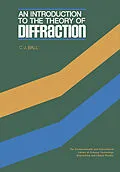An Introduction to the Theory of Diffraction presents the fundamentals of diffraction theory. This book discusses other topics, such as absorption in cylindrical or slab-shaped specimens, which do not closely involve the fundamentals of diffraction.
Organized into seven chapters, this book begins with an overview of the fundamentals of wave motion and a short account of the interaction of atoms with X-ray, electrons, and neutrons. This text then examines the differences between atomic scattering factors for the various radiations. Other chapters consider a number of problems in which the distribution of scattering sources is either one-dimensional in nature or can be reduced to one dimension. This book discusses as well the principle of superposition, which ensures that Fourier analysis has an application to diffraction theory. The final chapter deals with the importance of reciprocal lattice on the relation it bears to the crystal lattice.
This book is a valuable resource for metallurgists.
Inhalt
Preface
Chapter 1. Wave Motion
1.1. Introduction
1.2. Parameters of a Wave
1.3. Waves in Three Dimensions
1.4. The Principle of Superposition
1.5. Amplitude-Phase Diagrams
1.6. Secondary wavelets
Chapter 2. One-Dimensional Diffraction
2.1. Introduction
2.2. The Double Source
2.3. The Multiple Source
2.4. Diffraction by a Slit Aperture
2.5. Diffraction at a Straight Edge
2.6. The Diffraction Grating
2.7. Effect of Source Geometry
2.8. Abbe Theory of Image Formation
2.9. The Sinusoidal Grating
Chapter 3. Two-Dimensional Diffraction
3.1. Introduction
3.2. Propagation of a Spherical Wave
3.3. Fresnel Zones
3.4. Scattering by a Plane of Atoms
3.5. Diffraction by an Aperture
3.6. Diffraction by Arrays of Apertures
Chapter 4. Three-Dimensional Diffraction
4.1. Introduction
4.2. Geometry of Diffraction
4.3. Kinematical Theory of Intensity of Diffraction
4.4. Dynamical Theory of Diffraction
4.5. Real Crystals
4.6. Diffraction by Imperfect Lattices
Chapter 5. Scattering Processes
5.1. Introduction
5.2. Scattering of X-rays
5.3. Scattering of Neutrons
5.4. Scattering of Electrons
Chapter 6. Fourier Methods
6.1. Introduction
6.2. Trigonometrical Series
6.3. Exponential Series
6.4. Fourier Transforms
6.5. Convolutions
6.6. Transforms in Two and Three Dimensions
Chapter 7. Elements of Crystallography
7.1. Introduction
7.2. Lattices
7.3. Indices
7.4. The Reciprocal Lattice
7.5. Relations between Lattices
Bibliography and References
Index
